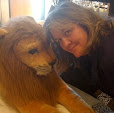We finally had our first snow last night and now it is cold. Didn't get above 20 degrees F today, but that didn't stop us from picking out the perfect Christmas tree. Holiday decorating is in full swing, and my first puzzle of the season is underway. I'm having my first hot chocolate of the season and looking forward to turkey sandwiches with leftover fixin's for dinner tonight.
John Forti, the Heirloom Gardener, shared this poem on Facebook this morning, and I fell in love with it.
November Comes and November Goes
by Elizabeth Coatsworth
Here's what I read in November:
The Art Thief, by Michael Finkel - everybody seems to be reading this right now, which is how I found out about it, and it is a compelling story. However, I came to loathe Stéphane Breitwieser, his girlfriend and accomplice, and his idiot of a mother who destroyed much of the art her son stole in order to save her skin.
What an arrogant twit of a human to steal art from not only museums, but castles, churches, and galleries all because the piece "moved" him. What about the rest of us who also are moved by art, who plan trips around visits to museums that house the works we want to see in person?
I was also so frustrated by the incredibly light sentences all three of these poor excuses for human beings received. And my annoyance with all involved in this book didn't end with the culprits or the lack of justice, but Michael Finkel, the author, also fell in my estimation when in the notes at the end he confessed that he was present when Stéphane stole a book out of the museum they visited together. Why Finkel didn't say, "go put it back" I will never know. He almost seemed to think it was funny. I didn't.
If I ever find out that Stéphane was compensated in any way for his participation in the creation of the book, I think my head will explode. All that said, it was an interesting book.
The Right Sort of Man by Allison Montclair - my JASNA friend, Pam, recommended this book, and I loved it. First in a series (Sparks and Bainbridge #1), the setting (post-WWII London) was terrific and the characters were so fun. Iris Sparks is a former trained spy who cannot talk about what she did in the war and Gwen Bainbridge is a war widow whose son is heir to a title. They meet at a wedding and decide to open a marriage brokerage (I guess before the advent of online dating there really were marriage brokers). One of their clients is murdered and another of their clients is charged with the crime--Sparks and Gwen don't think the police got the right man and so resolve to solve the case. I'm eager to read the next in the series, and it will be interesting to see if they remain in the marriage business or morph into detectives. One of the things that I really liked about this book is that both main characters grew and developed and learned stuff about themselves--they were real, multi-faceted people with baggage and a lot of heart.
The Grey Wolf, by Louise Penny - #19 in the fabulous Armand Gamache series, once again the stakes are sky high as Armand and his team race against time to find out who is behind the plot to poison Montreal's drinking water and how they can be stopped. We armchair travel to monasteries in Canada and France, and we spend quality time (never enough) in Three Pines. Be forewarned, however, this book ends with a cliffhanger, and the story is picked up in Penny's latest, The Black Wolf.
The Christmas Shoppe, by Melody Carlson - this was a yawner, at best a 3-star book but in actually more like 2.5. Mysterious woman comes to town, everybody is against her because she has a witchy vibe, she opens a thrift store, everyone who goes there finds an object that heals whatever wound has been festering inside. She disappears at the end. I wanted a great holiday read, but this was just same-old, same-old.
Now I am reading The Autobiography of Santa Claus, which is turning out to be much better!















































